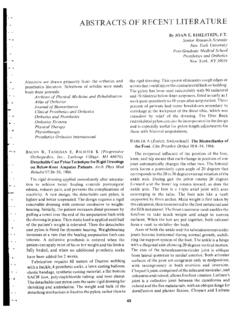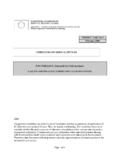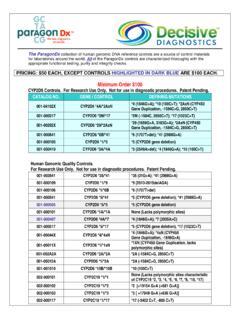Transcription of Seated Posture Scale 1 For Research Use Only--Directions ...
1 Barks L, Luther SL, Brown LM, Schulz B, Bowen ME, Powell-Cope G. Development and initial validation of the Seated Posture Scale . J Rehabil Res Dev. 2015;52(2): 201 10. Seated Posture Scale | Page 1 of 7 Seated Posture Scale1 For Research Use Only--Directions for Scoring Equipment Needed: Chair for scorer to sit on with seat same height as wheelchair, Small transparent plastic ruler with perpendicular lines to look through, at each body part, Small metal measuring tape Pen or pencil Position the person Seated upright in his or her wheelchair with all prescribed positioning equipment with hips against the back support of the wheelchair, arms on armrests or any other arm support (for example, tray or tray if used).
2 The observer should sit at the right or left side of the person in the wheelchair and begin observation and score the following items: Item Description Rating Score 1 0 0 0 1 0 HEAD 1 Sagittal head angle 2 Frontal head angle 3 Transverse head angle (Use eyes or ears as landmarks, whichever is TRUNK 1 Adapted from Gagnon, B., Vincent, C., & Noreau, L. (2005). Adaptation of a Seated postural control measure for adult wheelchair users. Disability and Rehabilitation, 271(16), 951 960. Barks L, Luther SL, Brown LM, Schulz B, Bowen ME, Powell-Cope G. Development and initial validation of the Seated Posture Scale . J Rehabil Res Dev.)
3 2015;52(2): 201 10. Seated Posture Scale | Page 2 of 7 Item Description Rating Score 1 0 0 0 1 0 4 Frontal trunk angle 5 Lumbar curve depth (look at lower back Posture in these pictures) 6 Thoracic curve depth (look at upper back Posture in these pictures) 7 Transverse trunk angle (use both shoulders as landmarks) UPPER EXTREMITIES 8 Right upper arm sagittal angle 9 Left upper arm sagittal angle Barks L, Luther SL, Brown LM, Schulz B, Bowen ME, Powell-Cope G. Development and initial validation of the Seated Posture Scale . J Rehabil Res Dev. 2015;52(2): 201 10. Seated Posture Scale | Page 3 of 7 Item Description Rating Score 1 0 0 0 1 0 10 Right upper arm frontal angle 11 Left upper arm frontal angle PELVIS 12 Frontal pelvic angle 13 Transverse pelvic angle (look at rotation of the lower body/hips for this item) LOWER EXTREMITIES Barks L, Luther SL, Brown LM, Schulz B, Bowen ME, Powell-Cope G.
4 Development and initial validation of the Seated Posture Scale . J Rehabil Res Dev. 2015;52(2): 201 10. Seated Posture Scale | Page 4 of 7 Item Description Rating Score 1 0 0 0 1 0 14 Right frontal lower leg angle 15 Left frontal lower leg angle 16 Right thigh-to-trunk angle 17 Left thigh-to-trunk angle 18 Right transverse thigh angle Barks L, Luther SL, Brown LM, Schulz B, Bowen ME, Powell-Cope G. Development and initial validation of the Seated Posture Scale . J Rehabil Res Dev. 2015;52(2): 201 10. Seated Posture Scale | Page 5 of 7 Item Description Rating Score 1 0 0 0 1 0 19 Left transverse thigh angle 20 Right thigh-to-lower leg angle 21 Left thigh-to-lower leg angle 22 Right lower leg-to-foot angle 23 Left lower leg-to-foot angle Barks L, Luther SL, Brown LM, Schulz B, Bowen ME, Powell-Cope G.
5 Development and initial validation of the Seated Posture Scale . J Rehabil Res Dev. 2015;52(2): 201 10. Seated Posture Scale | Page 6 of 7 Scoring Details For Research Use only 1. Sagittal head angle: If an imaginary line drawn from the nose to the chin is perpendicular to the wheelchair seat and parallel to a door frame or any other vertical line in the room, score 1. If the line slants down or up, score 0. 2. Frontal head angle: Sit facing the person. Draw the same imaginary line from mid-forehead through the nose to chin. If the line is parallel to a door frame or other vertical line in the room, score 1. If it tilts to the left or the right, score 0. 3. Transverse head angle: Look down from above the person s head.
6 Drop an imaginary line from each ear to each shoulder. If both ears are directly above the shoulders, score 1. If one ear is farther forward than the other, score 0. 4. Frontal trunk angle: Assuming the wheelchair seat is level, measure the height of the shoulder from the seat on the right and on the left. If both are the same height, plus or minus one inch, score 1. If one is more than one inch higher than the other, score 0. 5. Lumbar curve depth: Place your hand in the lumbar area of the spine just above the sacrum. If there is a forward curve present, such that you may easily place your hand from the side into the curve, score 1. If the curve is flat or bows out posteriorly so that the forward curve is lost, or anteriorly so that it is exaggerated, score 0.
7 6. Thoracic curve depth: With the hips still placed against the wheelchair seat back, observe the person from the side, looking for the normal S-curve of the spine. If the cervical spine forms the normal forward curve, the ears are directly over the shoulders, and the thoracic spine forms the normal posterior curve in the sagittal plane, with the lumbar curve below, score 1. If the thoracic posterior curve is slightly to extremely exaggerated in a slouched slump (kyphosis), score 0, even if the ears are over the shoulder. 7. Transverse trunk angle: With the hips still placed against the seat back, stand behind the person, locate the acromion processes by placing right and left index fingers on them.
8 Estimate whether one is farther forward. If the distances are equal, score 1. If one distance is greater than the other, score 0. 8. Right upper arm sagittal angle: Observe from the side with the arms on armrests or laptray. If the upper arm is perpendicular to the flexed forearm, score 1. If it is not, score 0. 9. Left upper arm sagittal angle: Observe from the side with the arms on armrests or laptray. If the upper arm is perpendicular to the flexed forearm, score 1. If it is not, score 0. 10. Right upper arm frontal angle: Observe from the front, with the arms on armrests or laptray. If the upper arm is perpendicular to the floor at <10 angle, s core 1. If it is not, score 0. 11. Left upper arm frontal angle: Observe from the front, with the arms on armrests or laptray.
9 If the upper arm is perpendicular to the floor, score 1. If it is not, score 0. 12. Frontal pelvic angle: Stand or sit in front of the person. With the person s hips still against the seat back, place your index fingers on the anterior superior iliac spines (ASISs) of the pelvis. Observe from the front, with the eyes level with the pelvis. If the ASISs are level, score 1. If one is higher than the other, score 0. 13. Transverse pelvic angle: Standing in front of the person, place your index fingers on both ASISs again, and with the hips still placed against the seat back, look down from above, estimating Barks L, Luther SL, Brown LM, Schulz B, Bowen ME, Powell-Cope G. Development and initial validation of the Seated Posture Scale .
10 J Rehabil Res Dev. 2015;52(2): 201 10. Seated Posture Scale | Page 7 of 7 whether either ASIS is located farther from the seat back than the other. If both are equal distances from the seat back, score 1. If one distance is greater than the other, score 0. 14. Right frontal lower leg angle: Seated in front of the person, look at the right foot in relation to the right kneecap, with the person s hips still positioned against the seat back. If the foot is directly below the knee, then the hip is not rotated score 1 (if the person is not an amputee). If the foot is either lateral or medial to the knee, then the hip is rotated score 0. If the person has a below-knee (BK) amputation, draw an imaginary line along the tibia.



















